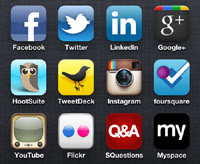Pinterest, the newest thing in social media, is really exploding these days - people are joining left and right, pinning their favorite stuff to personalized pin boards online.
It's all well and good for it to be so popular, but the real question is, does your business need to be on it? Here's a few facts and figures to help you decide.
1) Who is using it?
A super-majority of women, which is great, because women make 85% of household purchasing decisions, and in some cities, are better educated and make more money than men.
According to
this post on Quora, 80% of users are women, the key age group is 25 to 44, 25% of users have a bachelor's degree or more, and household income ranges from $25K to $75K.
There are three main groups using the site:
- Boomers and who are interested travel and their DIY
Babies.
- Working moms who are power shoppers and want coupons on upscale or upscale-looking items, and prioritize convenience.
- Young, middle-class, active families who want to balance work and parenting, need recipes, child friendly activities, advice for healthy living.
2) What are people pinning?
A quick drive through Pinterest shows people doing a lot of wedding planning, style picks, household and craft things, cool photography, and, of course, kittens.
This article from
PC Magazine asserts that there's a growing variety of categories on the site. There's a lot of crafting (knitting, collage, etc), food, interior design, and especially fashion and beauty, but also tattoos, cars, art photography, travel, pets, and humor. The better the photographic quality, the more likely it is to get pinned. There's a growing community of teachers on there trading lesson plans and ideas.
Pinterest is also more aspirational than some other networks. On social networks like Facebook, people talk about what they are currently doing, making, wearing, etc. On Pinterest, users can show people what they
wish to do, wear, eat, sew, go to, look like, etc., but they may or may not have the means to obtain any of those things.
See
this slideshow to learn more about what people are doing on the site.
3) Is there an e-commerce connection?
People certainly are pinning a lot of buyable things, but there don't seem to be any hard numbers out there yet on how much revenue Pinterest could be driving. There's quite a bit of potential, though. A certain number of people who pin things they like will eventually buy those things, and since the URL stays with the image, pinned images do drive site traffic.
4) How many people are on it?
ComScore reported
11.7 monthly Pinterest users in January, 2012, part of a steep user growth curve. According to this
TechCrunch article, there were ten million users on Pinterest as of February 12, 2012, with 20% using the site daily.
5) What's the Double-X Factor?
Per the same article, as many as 97% of these users may be women - a higher number than PC magazine provides. This isn't a bad thing. Though I've heard more than one person describe Pinterest as a "pacifier for women," I think these people are missing the big picture. Businesses have a huge opportunity on Pinterest to appeal to their primary audience demographic -women.
She-conomy shares some
pretty amazing facts about female buying habits - I think these are worth a reprint:
In the US, women account for 85% of all consumer purchases including everything from autos to health care:
- 91% of New Homes
- 66% PCs
- 92% Vacations
- 80% Healthcare
- 65% New Car
- 89% Bank Accounts
- 93% Food
- 93 % OTC Pharmaceuticals
American women spend about $5 trillion annually…Over half of the U.S. GDP
- 22% shop online at least once a day
- 92% pass along information about deals or finds to others
- 58% would toss a TV if they had to get rid of one digital device
So, women flocking to Pinterest to keep track of things they might like to buy is worthy of sexist ridicule because...?
I know, I couldn't answer this question either.
For a rundown of sexist coverage on Pinterest's success,
click here for Mary Sue.
6) Are there businesses with successful Pinterest presences?
Yes, in fact, Pinterest has started its own
pinboard of case studies of people who've driven traffic and sales with Pinterest.
A few examples:
Kate, a hairstylist and jewelry maker had a small blog that now has
millions of pageviews because she has been posting photos of her hairstyles with links back to her site to the how-to videos to make the styles.
I posted about
how-to videos a few weeks ago. Here's another great way to use them.
A UK flooring company is using Pinterest to show off their product and help people connect with them across other social networks as well. McKay flooring says that Pinterest has driven a high amount of traffic to their web site and blog, even allowing them to find ideas for blogging, and to help them get DIY tips out to customers.
According to Mashable, 9% of the top 300 retailers
now have a Pinterest presence. Some of the most followed users are graphic designers, interior designers, and other creative folks.
How are big brands using it?
- Whole Foods is pinning foods and recipe ideas.
- DIY queen Martha Stewart is pinning entertaining and decorating ideas.
- Better Homes and Gardens has multiple boards with recipes, decorating, and holiday tips.
- Bergdorf Goodman is serving your inner shopaholic
- The Today show is one of few non-stuff oriented boards - showing news and related images
- Travel Channel - for the aspirational traveler in you. Where would you like to go?
7) How can you use Pinterest to grow your own business?
If you have your other social media presences straightened out and you’re looking for new territory, Pinterest might be a good tactic….
If you're in a creative business, whether you're a graphic designer, photographer, interior designer, fashion designer, restauranteur, travel planner, knitter, crafter, or anything else in that vein, take pictures of your stuff, post them to your blog or web site, and pin them on Pinterest. Link it back to how-to-make, how-to-use, or how-to-wear ideas and see traffic climb.
Follow and support other users - many PInterest success stories mention that they get great ideas from Pinterest all the time - it's another way to dialogue with people who love doing what they do.
According to
this Shareaholic study, Pinterest Drives more traffic than Google+, YouTube, and LinkedIn Combined.
Have you given Pinterest a whirl? How was it? Please share.
















